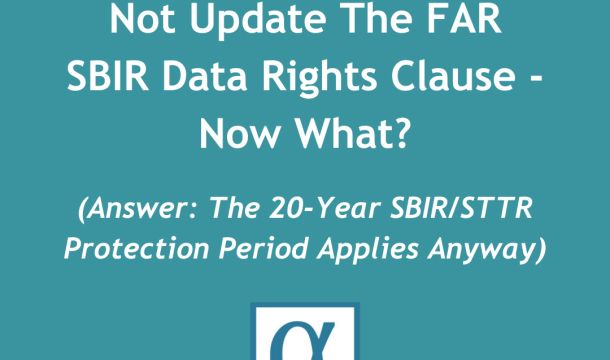The GovCon Bulletin™
08
Feb, 2023
Technology Defense Contractors Take Note: DoD’s Proposed Rule Extends Time To Challenge Technical Data Rights Restrictions
Recently, on January 30, 2023, the U.S. Department of Defense (DoD) issued a notice giving contractors and the public more time to comment on a rule that DoD first proposed in December 2022 concerning DoD’s right to challenge restrictions on technical data. Technology companies and innovators should take note of the proposed change in case it signals a more aggressive posture by DoD with regard to technical data underlying background intellectual property that contractors incorporate in their contract deliverables.
But the key takeaway is this: Technology contractors should also make sure they have an updated technology inventory in case they do face a challenge.
The Proposed Rule Change & DoD Challenges To Technical Data Rights Restrictions
In our white paper on the federal contracting rules on inventions, software and data, we have a fuller discussion of the allocation of rights with regard to technical data and computer software. Briefly for now, in general, the rules under FAR and DFARS allocate to the federal government certain rights to computer software and technical data that a contractor generates or uses while performing under a government contract. Under these rules the government typically does not acquire ownership rights or title to the software or data, and a contractor generally retains any ownership of the data or software that it generates or brings to a government project. Rather, the rights that are allocated to the government under FAR and DFARS typically relate to the government’s rights to use the data and software and to disclose it to others.
In general, the federal government’s rights are the greatest with respect to data and software that a contractor creates with government funds. So, for example, under FAR and DFARS any new software and new technical data that a contractor creates while performing under government contract is typically subject to the government’s unlimited rights to use it and to distribute it to third parties. This seemingly reflects the notion that if it was created on the government’s “dime” the government should have fairly broad rights over it.
On the other hand, the government’s rights are typically limited or restricted with respect to data or software that a contractor uses during contract performance but that was first created or generated exclusively with private funds. These limited or restricted rights may, for example, permit a federal agency to use the data or software for government purposes only. They also may prohibit a federal agency from distributing it outside the government. An exception to these general principles occurs under Small Business Innovation Research/Small Business Technology Transfer Program under which the government's rights to data and software created during the funded project are limited or restricted for a period of time before they revert to unlimited rights.
In instances in which restricted or limited rights apply, a government contractor is required to alert a government agency before it turns over software or data that may be subject to these limited or restricted rights. A contractor provides the notice to the agency by placing restrictive markings on the software or data. Under the current DFARS clause 252.227-7037, the government has, with a few exceptions, up to three years after either delivery of technical data or final payment to the contractor, whichever is later, to challenge the validity of a restriction on technical data. The consequence to a contractor of losing a challenge is that the federal government can then cancel or ignore the restrictive markings, and, thus, is not bound by the related restrictions.
And this is where DoD’s proposed rule change comes in. Under the change that DoD proposes, the time period under DFARS 252.227-7037 in which DoD can assert a challenge to a restriction on technical data is extended to six years after the later of final payment or delivery of the technical data. Comments to the proposed rule can now be submitted on or before March 16, 2023.
A Technology Inventory Can Help Prepare Contractors For Challenges
Whether the extended challenge period reflects a more aggressive stance by DoD with regard to challenges of data restrictions is unclear. But it serves as a reminder that technology defense contractors should have in place a technology inventory that they can rely on in case they face a challenge to the technical data restrictions that they assert.
The technology inventory should help contractors track any existing technical data and software that they may use in a government contract. The technology inventory may, for example, identify whether technical data or software was developed with government or private funding, what documents or information reflect the funding source, and whether the technical data or software has already been used in connection with a government contract and what restriction was asserted (e.g., limited rights, restricted rights, SBIR/STTR data rights, etc.). Lastly, government contractors should make sure that their document and information retention policies will enable them to preserve the technology inventory and information that supports any data or software rights restrictions that they may assert.

Mark A. Amadeo
Principal


